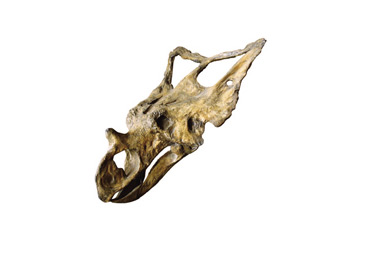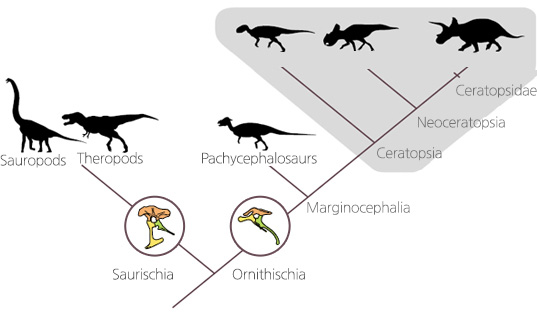Evolution of ceratopsian dinosaurs
Ceratopsian dinosaurs are a unique group of ornithischians found only in Asia and North America. They commonly have large body mass of few tons like Triceratops, walk on four legs, have wide frills around the neck, and have facial horns. However, the earliest ceratopsian dinosaurs from Asia show completely different forms.
Early Cretaceous Psittacosaurus that was small and walked on two legs did not have frills or sharp horns, and only had a parrot-like beak characteristic to ceratopsian dinosaurs. The little herbivore had to digest the food it consumed with its sparse teeth with the help of gastroliths. Afterwards, the ceratopsian dinosaurs gradually expanded a part of the head to develop the frills. As the body mass increased, the front legs touched the ground and walked on four legs.
In the Late Cretaceous, the asian ceratopsian dinosaurs moved to North America, which was connected by a narrow land bridge, and evolved rapidly throughout North America, adapting to tough food by developing tooth-batteries that cut like scissors.

Psittacosaurus

Triceratops
The frills, known for their distinctive features, vary in shape and size, and early ceratopsian dinosaurs such as Psittacosaurus did not have frills. It was once considered a shield, but in fact most frills have large and small openings and are very thin, making it difficult to imagine being used as a defense.
Instead, the high and wide frills make you appear larger, so they are believed to have been used as threats to the enemy, for attracting mates, or for identification purposes among groups.

Protoceratops

Centrosaurus

Chasmosaurus

Evolution of the ceratopsian dinosaurs and cladogram
Characteristics of evolved ceratopsian dinoaurs such as Triceratops are cumulative effects of gradual changes since the earliest ceratopsian dinosaurs. Beak-like rostral bone and triangularly protruding jugal bone are from early ceratopsian dinosaurs such as Psittacosaurus, and fused cervical vertebrae started from the Neoceratopsia such as Protocerastops. Enlarged external naris and nasal horn and well-developed tooth-batteries appeared later within Ceratopidae (Fastovsky & Weishampel 2009).